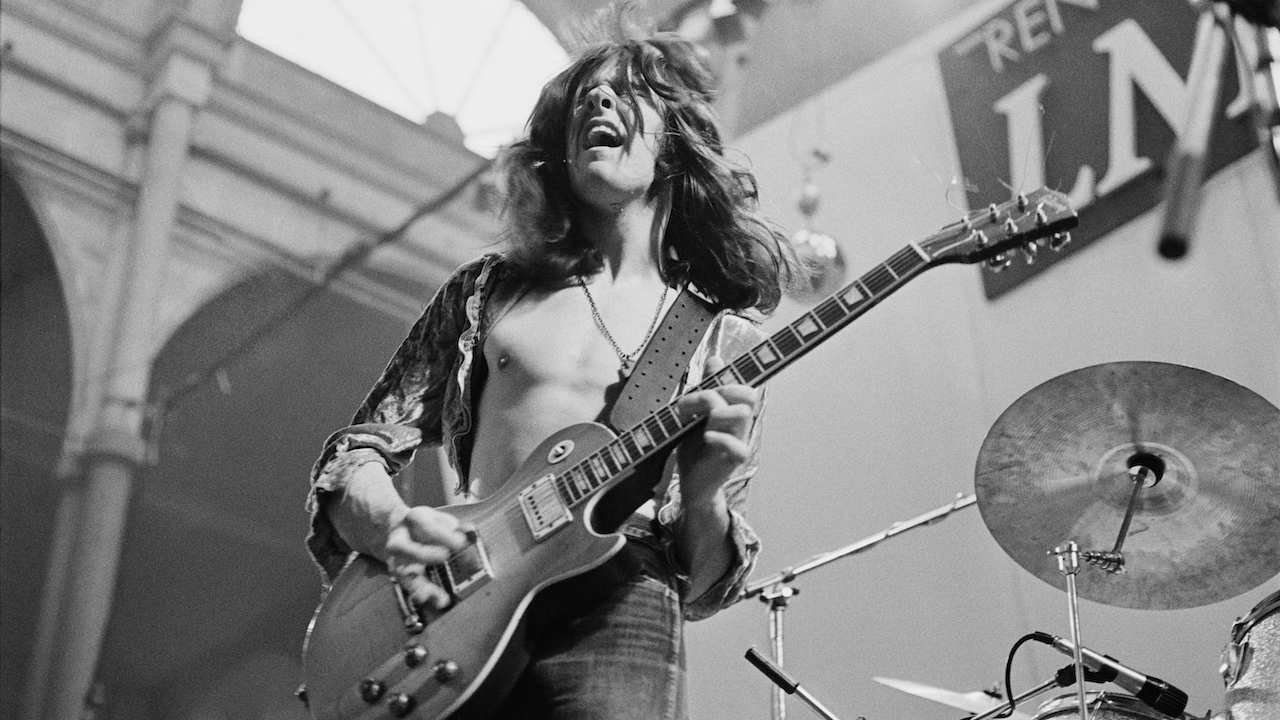How to play like Gary Moore – the rock and fusion years
Learn Gary Moore's style and technique from the mid 1970s through to the late '80s with these licks and soloing examples

Before returning predominantly to his earliest influences in 1990 with a series of blues albums, Gary Moore turned his hand successfully to a wide variety of styles, always managing to sound utterly convincing. In this feature, we’ll be looking at his transition from fusion to rock between circa 1975-1989 via four ‘in-the-style-of’ solos, with an emphasis on his aggressive, ‘take no prisoners’ fast-picking style.
For his 70s ‘fusion’ period, Gary tended to use a Strat most often, frequently adding manic vibrato with the whammy bar. You’ll hear this on Colosseum II’s Electric Savage, Variations (with Julian Lloyd Webber) and Back On The Streets – though the Peter Green Les Paul did of course also appear on a few tracks, notably Parisienne Walkways.
By this time, Gary was about to play another stint in Thin Lizzy for the Black Rose album, shortly before switching gears (and bands) to form the melodic rock outfit G-Force, perhaps looking to build further on the momentum his solo career had previously begun to accumulate. (It’s worth noting that the hard rock album Dirty Fingers was also recorded around this time – 1980 – but this was held back until 1984.)

These settings are based on how Gary may have set his Marshalls, producing massive low end through a 4x12 cab. He used various drive pedals, such as the Ibanez Tube Screamer and Boss DS-1, though it’s pretty clear the sound came from Gary as much as it did his gear. You can use a single-coil or humbucking guitar for any of the examples, though some of the more modern tones require more gain and perhaps dial back the high mids.
In 1982, Gary consolidated his solo career with Corridors Of Power, still a melodic album, but edging back towards a rockier, less ‘modern’ sound. The Dirty Fingers-style guitar workout at the beginning of End Of The World (Dirty Fingers was also a hot Gibson humbucker!) shows that while Gary might have been curious about other genres, he’d lost none of his fire.
Victims Of The Future confirmed this further when it came the following year. Gary was still relying mostly on Strats; by now, he had acquired the fabled Red Strat (with a couple of reissues for back up on tour). The intro to Murder In The Skies demonstrated that Gary had no intention of moving over for Van Halen or anybody else! The clarity and snarl of those single coils left nowhere to hide and the guitarist’s accuracy and control is impressive. Gary toured the world the following year, resulting in the We Want Moore double album in 1984.
The Strats were still getting heavy use, but he also started using various Ibanez Roadstar models, then Hamer and Charvel as the mid-'80s really began to swing. By 1985, Gary had found a comfortable mix between his hard rock sound and a modern production. Run For Cover was definitely more of a ‘humbucker’ album and the Floyd Rose whammy saw tasteful use on many occasions.
By now Gary’s tone is more distorted and focused, swapping his classic Marshall/Tubescreamer rig for the solid-state Gallien Krueger 250ML (into Marshall cabs), using the onboard stereo chorus - of course. The remaining two albums of the decade; Wild Frontier (1987) and After The War (1989) are pure rock, but occasionally show Gary reflecting on his Celtic roots. These are the last of the ‘rock’ albums before Still Got The Blues hit in 1990.
Technique focus: picking
Though very fluid and accurate, Gary’s playing always managed to keep its rough edges, even in the fusion years. The most common advice about developing picking accuracy is to slow things down – and this is perfectly true, but it is also worth taking note of your picking hand posture, and how it changes as you start to turn up the tempo.
Try tremolo picking as fast as you can on one note while looking at your arm and hand position - your brain and hands will likely have unconsciously optimised your economy in motion more than when you run slowly through exercises. You are likely to make gains far more quickly if you consciously adopt a similar hand posture when working on alternate picking.
Pt. 1: Warm-up exercises
Example 1 Though a formidable picker, Gary also had a neat line in hammer-ons and pull-offs. This example paraphrases a pattern he was fond of in the earlier ‘rock’ era (80-83). Don’t feel you need to jump straight in at 120 bpm, and remember the old watchword, “speed is a result of accuracy”.
Example 2 Gary liked to play in groups of four, and this alternate picked ascending sequence is inspired by his solo on Out In The Fields. Note the palm muting which gradually decreases as we ascend - this helps with definition at high gain or volume, and sounds great!
Example 3 Alternate picked triplets were another favourite, in this case with minimal changes of string, which makes things slightly easier. However, this does require accuracy as the pattern shifts horizontally along the string. Palm muting and a firm attack help here once again.
Example 4 These picked triplets, outlining the harmony of a maj7th chord, were a real ‘go-to’ lick for Gary before he consciously moved to a bluesier style. There’s no getting around it; this is tricky and you may want to refer to the Technique Focus boxout for some hints on getting up to speed.
Example 5 This lick moves from slow to fast, demonstrating how Gary would subtly alter the sequence to enable this. Also, pay particular attention to how the picking-hand technique changes, using a rake across the third and second strings, followed by an upstroke again on the second string. It can feel odd at first, but this is the key to unlocking the speed of the last section. Remember you can always try these licks slowly and build them up to speed.
Backing track:
Pt. 2: '70s fusion
In at the deep end... This kind of disciplined, alternate picked melody is all over Colosseum II’s Electric Savage album, frequently doubled or harmonised with Don Airey’s synth, as I’ve done here.
Take your time to ‘programme’ the lines into your brain and be sure to keep a steady, consistent pick attack. I’ve marked the sections where it’s all about alternate picking, including the string crossing arpeggios in the last section.
Don’t forget about the manic whammy vibrato (perhaps learned from Ritchie Blackmore)! This solo makes a great exercise, but be prepared for it to take some time.
Backing track:
Pt. 3: Early '80s rock
You’ll hear this kind of soloing from Gary on the earlier 80s albums, such as Dirty Fingers and Corridors Of Power. It isn’t all fast picking, though – quite a lot of the songs and solos take a very melodic approach, and I’ve put in a few lines to emulate Gary’s precise and confident melodic side, to set things up for the trickier stuff. There’s a good mix of techniques here that draws from almost all the warm-up exercises.
Backing track:
Pt. 4: Mid-'80s rock
This is set up with some more melodic lines for the first eight bars, before getting into some faster picking in the second half, with a repetitive arpeggio lick, then an ascending line similar to the one he plays in Out In The Fields.
This is designed to reflect the growing sophistication in Gary’s production and phrasing, while still keeping all the right rough edges. Gary wasn’t afraid of the odd open string, or clashing into adjacent bent strings.
Backing track:
Pt. 5: Late-'80s Celtic
In the later '80s, Gary revisited the Celtic rock sound he’d helped pioneer with Thin Lizzy. There are a few pull-off licks before digging in with some alternate picked triplets, building carefully to land on the G in time for the second half.
Here, we find more fluid fast licks of the kind that feature on Gary’s later blues material, when he consciously moved away from such aggressive picking. However, we return there for a last fling with the ascending phrase at the end.
Backing track:
Get The Pick Newsletter
All the latest guitar news, interviews, lessons, reviews, deals and more, direct to your inbox!
As well as a longtime contributor to Guitarist and Guitar Techniques, Richard is Tony Hadley’s longstanding guitarist, and has worked with everyone from Roger Daltrey to Ronan Keating.
She wowed Sonny Landreth and Carlos Santana called her the “future” – Erja Lyytinen shares her 6 go-to slide licks for unlocking more expressive soloing
“He combined the passion of Gary Moore with riffs inspired by Zeppelin and Deep Purple, plus unexpected melodic twists like Ritchie Blackmore”: He was one of ’80s rock’s great journeymen – and his searing hot lead work inspired Marty Friedman











